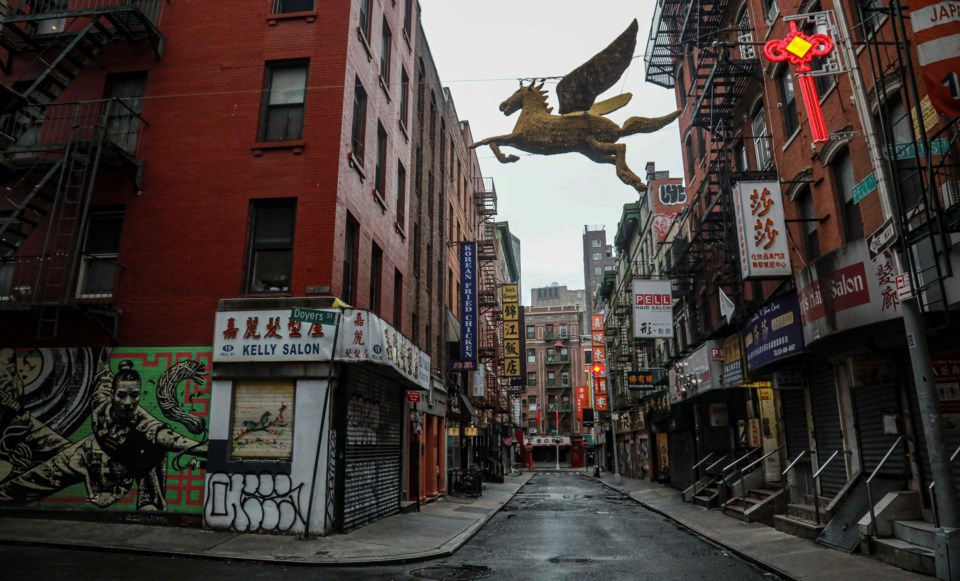NEW YORK — Hopeful birdsong and foreboding sirens. Chiming church bells and bleating ferry horns.
The coronavirus crisis has drastically transformed the world in sound. The routine cacophony of daily life has calmed, lending more weight to the noises left behind. And in those mundane sounds, now so unexpectedly bared, many have found comfort, hope and dread.
Here in the U.S., in the grind of the pandemic, sound has become a shared experience, in joy and sadness. The eyes may be windows to the soul, but these days, as isolation persists, the ears feel tethered to our hearts.
“After
In European hot spots, there's balcony singing. In New York, at 7 p.m. for the duration, the city ignites for a few moments in whoops and claps as the home bound lean out their windows making noise together.
It's not the sounds but the silence that has made us master eavesdroppers, with an eerie recognition of overheard snippets in New York streets and parks as the sheltered venture out, if just for a little while:
“It looks good long,” a woman reassures.
“Don't touch buddy. You can't touch anything, remember,” a father warns.
“Yeah but we're not making any money right now, so," a businessman explains.
“Look, mama, the birds,” a small girl notices, looking up into trees.
In another hard-hit city, San Francisco, 58-year-old Markus Hawkins is a visually impaired musician and massage therapist who lives alone in the Tenderloin district above a bakery, still open, and next to a restaurant, ordered shut.
His life is guided by aural cues, and they've changed dramatically. With the city largely silent, his world feels intensely louder.
“Oh my God, it's been difficult,” Hawkins said.
There's the constant door slamming from the bakery, and an industrial compressor for a freezer or refrigerator that clicks on every two to three minutes, 24 hours a day, creating “this horrible buzz.” Pre-lockdown, they went ignored.
At night, he lost his soothing white noise: an exhaust fan from the restaurant. And he hears conversations. Lots of conversations, because “nothing is drowning them out.”
Kamil Spagnoli, a 42-year-old single mom of two grade-schoolers, is also visually impaired. She uses a cane to get around Stony Brook, where she lives east of Manhattan near a hospital with a high-level trauma
“Did it mean people were getting treated?” Spagnoli wondered. “Now, there's nothing.”
She, too, is doing without familiar sounds that help with routine things. She listens for traffic flow to cross streets. The silence feels dangerous.
“Now there's no traffic. I'm not going anywhere,” Spagnoli said. “I can't get a sense of what's around me visually and I need that sound feedback.”
In Seattle, another early U.S. hot spot, fewer ferries means fewer familiar horns that normally punctuate each day like an extra clock. There are worries there as well playing out in sound and silence.
Is that fire truck in the distance rushing to help someone who can't breathe? Will the noisy weekend crowds return to the city's popular, now empty Space Needle?
Early in the American outbreak, the Life Care Center in the Seattle suburb of Kirkland saw more than 129 people sickened and more than three dozen die from the virus, making it the epicenter before the insidious spread.
The sounds of sirens as ambulances turned up a hill to the nursing home brought on immediate dread for loved ones and others gathered outside. Weeks later, after the threat moved on, fewer ambulances made that turn, continuing to other destinations.
But where? The emergency is too big to know exactly.
Other sounds now soothe. As spring descends, birdsong is prevalent.
There's the quirky squeak of the American goldfinch, owl-like coos of mourning doves and the whinnying of the downy woodpecker as Central Park offers avid urban birders some respite.
There are no services to announce or ceremonies to mark in locked down areas, yet church bells ring on, uplifting many of all faiths who barely took notice in happier — and noisier — times. It's a phenomenon Isaac Weiner finds historically ironic.
The associate professor at Ohio State University researched centuries of church bell ringing and controversy for his 2013 book, “Religion Out Loud: Religious Sound, Public Space, and American Pluralism.”
“There are traditions that during times of plague and epidemic, many churches would often voluntarily refrain from ringing bells,” Weiner said. “There was fear that the bells might exacerbate people's illnesses in their time of convalescence.”
As the sick and dying multiply, the bells of today serve as a steadfast call to action: Keep listening.
___
Associated Press religion coverage receives support from the Lilly Endowment through the Religion News Foundation. The AP is solely responsible for this content.
___
Leanne Italie, The Associated Press



